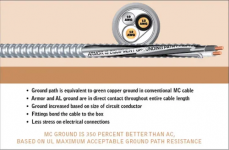Rex, I have read stereophile and know a bit about who you are.
We live in an age where almost nothing is a linear load. A true audiophile should be taking a long hard look at everything in their house.
It becomes a lot more complicated when one camp is SET, horns, and vinyl and another is digital and class D amplifiers. IMHO nothing in the audio chain is more broken than loudspeakers.
Balanced power need not be expensive. A decent single phase 480 X 240 transformer will suffice. I wouldn't want a toroidal.
Thanks Russ,
The speaker and the room!!!
Yes they should take a hard look at their house. Asia is a completly different philosophy than the USA. They pride themselves on having a dedicated utility power transformer and OFC copper through out the entire audio power system. Europe is half way there. They have better cable they can use. Again, shielded OFC branch wire they spend $20 to $60 a foot on. In the USA, people ignore what is behind the wall and spend $7000 on a Shunyata or Audioquest this or that conditioner, then run $5000 per cable, power cords to everything. I have seen at least $50K in just power cords on projects. I am not going to say its snake oil, or its colorations. What I know is when I ground a house proper ( this is not easy to do), rework a panelboard properly, route branch circuits correct, use the right wall boxes, its an amazing enhancement in performance. Not only in audio, but video too. And internet data transmision is more stable. No drop outs.
I have tried a few transformers. I always hear them. They have a strong sonic signature. Sometimes they work, other times not. A 2.4KVA topaz worked great with my CJ Premier 140. It was god awful terrible with a Rega Osiris. A small triplite really brought a quiet and dynamics when powering all my date utilities (modem, router, switch). And my data has rock solid performance.
I have no desire to be a sales rep for product. If I sold a transformer and the customer did not like the sonic change it brought, I would then own the transformer. Than can end up in thousands in losses to get rid of it. Remember, my customers usually have about $200K to $600K in audio equipment. They are going to hear the transformer. And the only one I would trust to perform is a Torus. They start at $12K and go up from there. And the transformer needs to be close to the outlets. Transformers are noisy. If I put it in another room and run a non shielded wire from it to the rack, I have done nothing for RF. All I have done is block DC from the utility. And balanced the phases.
People may not realize it but we can hear every power cord with this equipment. I have heard the difference taking 3 x TEW 10 AWG, twisting them, putting them in techflex and adding ends as opposed to the same with mylar and a drain over the same set of wire. As the noise goes down, the detail comes out. Ergo, can I shield my branch circuits. I just don't want to use MC. As soon as one of these guys adds a non isolated ground receptacle the MC is a liability. Fremers home had MC for the branches. He had a non isolated receptacle at the amps and preamps. His ground loop via the case was loud. Probably 35 db at the chair. I agree MC is better. That is why its used in recording studios. But the technicians in studios don't remove the receptacles you put in and replace them with some fancy $500 duplex. They leave it alone.
My take from this thread is, every inspector is going to have an opinion. Just like here. If I spec a shield, I am going to have to have a sample on the job and have the AHJ authorize it before its built up and installed. I need the drain to be 12awg, and the shield needs to be bonded properly around the NM-B, and should be robust enough to provide a low impedance path to trip the circuit breaker.
I think I have a plan. Time to build up some test cables and install them in a system to test.
Thanks you all for your input.
Rex

